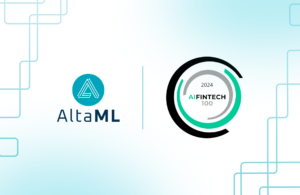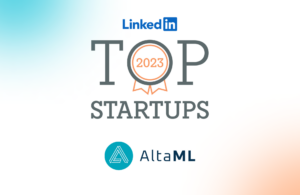Realizing the Potential of AI: Overcoming Adoption Barriers
May 25, 2023
•
5 min read
Cory Janssen
Co-Founder & Co-CEO
Artificial intelligence (AI) has become an essential part of modern enterprises, revolutionizing almost every sector and industry. However, many organizations face challenges in adopting AI due to the quick pace at which it is evolving, making them vulnerable to being left behind. AI adoption requires an important change within the enterprise that includes developing new skills, learning new ways of executing operations, and embracing completely new ways of thinking.
To achieve successful AI adoption, it is crucial that the organization’s entire workforce comprehends the purpose of the AI solution, adjusts to the changes it will bring and recognizes its potential as a powerful tool for driving business success. For organizations to achieve this transformation, it is imperative to understand the common barriers to AI adoption and learn how to overcome them effectively. They must also implement best practices for successful AI adoption, such as securing buy-in from executive decision-makers and end-users, educating the workforce and carefully selecting the most suitable use cases for the organization. By prioritizing these crucial factors, organizations can further ensure that AI adoption is seamless, effective and fully capitalizes on its potential to deliver transformative benefits.
First Up: Overcoming Common Barriers
To ensure a concrete shift toward AI adoption, it is essential to take specific steps. Organizations must overcome various challenges that arise during AI adoption, and here are five of the most prevalent:
Talent Shortage
AI adoption requires a wide range of different specialized professionals to coordinate their efforts in pursuit of a common goal. Finding the right team of professionals is far from simple, particularly due to the high demand for these skills in today’s market. In fact, by 2025 it is estimated that 97 million people will be needed for jobs in AI. To overcome this barrier, organizations can partner with third-party AI providers that can accelerate their AI adoption journey by leveraging their specially trained team’s talent and expertise across industries to build AI solutions.
Data Quality
Data quality is a critical aspect of successful AI adoption, as the accuracy and reliability of the data used to train and test AI models directly impacts their performance and effectiveness. Poor data quality can lead to biased models, incorrect predictions, and unreliable insights, ultimately hindering the success of an AI project. While it’s important to ensure data quality, organizations should not get caught up in trying to achieve data perfection before beginning their AI adoption journey. Organizations should prioritize getting started with the data they have and take an iterative approach to refine and improve its quality over time, achieving meaningful results more quickly and continuing to refine their models as they gather more data.
Lack of Understanding
A lack of understanding is another significant challenge in AI adoption as executives, employees and end-users may have apprehension, skepticism, and fear of adopting AI. While fear may seem like the most impalpable barrier to AI adoption, it is also one of the most deeply rooted. Thus, education and demonstrated experience are the best way to ensure buy-in.
Security and Ethical Concerns
The data used for AI’s training must be protected to avoid malicious interference, breaches or losses that could harm organizations, employees and customers. Transparency and good data hygiene are essential for establishing safe procedures to collect and maintain data over time. Companies should also stay up-to-date on regulations and best practices in the industry and work with ethical AI experts to ensure that their AI systems are designed and implemented in a responsible manner.
Absence of Strategy
Organizations that lack a clear AI strategy may struggle to implement AI effectively, resulting in failed projects or low return on investment (ROI). Additionally, it is essential to ensure that AI initiatives align with broader organizational goals and objectives to avoid wasting resources on AI solutions that do not align with the company’s overall direction. Therefore, organizations must develop a clear AI strategy, identify specific use cases with a tangible ROI, and establish a governance framework to ensure effective implementation and monitoring of AI initiatives.
Theory to Practice: Key Factors for Successful AI Integration
Buy-in
The success of AI adoption hinges on two critical elements: buy-in from executive decision-makers and buy-in from end-users. The former is essential for securing the necessary funding, resources and strategic vision to implement AI solutions effectively. However, without the latter, even the best-funded and most well-planned AI initiatives are doomed to fail. Achieving buy-in from end-users is no easy feat, as it requires convincing individuals to change their existing habits, routines, and workflows.
This necessitates a comprehensive approach that provides support, training and education to help end-users overcome any resistance or reluctance. A critical aspect of this approach is ensuring that end-users understand the value proposition of AI solutions and how they can benefit from them. By focusing on high-priority use cases and demonstrating tangible benefits early on, organizations can build momentum and enthusiasm for AI adoption, leading to more widespread buy-in across all levels of the organization. Ultimately, achieving buy-in from both executive decision-makers and end-users is essential for driving successful AI adoption, as it creates the necessary conditions for seamless integration and long-term sustainability.
Educate and Increase AI Literacy
As lockdowns during the pandemic forced many organizations to shift toward remote work models before true readiness was achieved, we learned about the destructive impact of digital illiteracy. The same is going to happen to AI if an organization’s workforce is unable to understand the technology they are working with. Employees must learn new skills, starting with how to understand data and how to collect it, how to help AI learn and evolve, and how to integrate these technologies into everyday working practices.
Companies should take the following actions: foster a culture of continuous learning, provide hands-on training opportunities, and encourage collaboration between departments to develop and implement AI initiatives that align with business goals. Additionally, educating executives and end-users about AI can help dispel myths and unfounded fears surrounding the technology, which can otherwise hinder adoption. Therefore, investing in AI education is not just an essential step toward successful AI adoption but also a means to drive organizational growth and innovation.
Prioritizing Use Cases
Prioritizing use cases is a critical step in the successful adoption of AI. By focusing on the use cases that offer the greatest potential impact and value, organizations can achieve tangible results and build momentum for further adoption. It’s important to prioritize use cases that align with business objectives, have a clear ROI, and can be implemented with existing data and technology infrastructure. This approach helps to avoid wasting resources and getting bogged down in projects that may not yield significant results. Additionally, prioritizing use cases can help build buy-in from stakeholders and demonstrate the value of AI to the organization. Ultimately, prioritizing use cases helps organizations achieve meaningful and sustainable benefits from AI adoption and allows teams to focus on higher value work.
The Bottom Line
AI adoption is a critical means for organizations to improve efficiency, reduce costs, and enhance productivity and profitability. However, the successful adoption of AI requires more than just implementing the technology—it necessitates a fundamental shift in workflow and culture. To facilitate this transformation and ensure a smooth and streamlined AI adoption process, companies must take measures such as addressing potential obstacles, educating employees, and fostering a culture of innovation. By prioritizing these steps, companies can maximize the benefits of AI adoption while minimizing any associated disruptions.
 Navigating Bias in AI with Open-Source Toolkits
Navigating Bias in AI with Open-Source Toolkits
 AltaML Secures Spot on AIFinTech100 for Consecutive Year
AltaML Secures Spot on AIFinTech100 for Consecutive Year
 Jurisage and CiteRight Finalize Merger, Become Jurisage Group Inc.
Jurisage and CiteRight Finalize Merger, Become Jurisage Group Inc.


